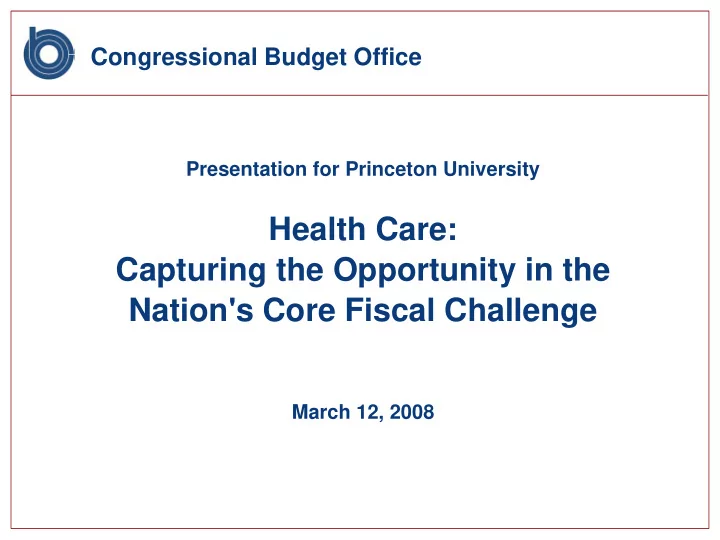

Congressional Budget Office Presentation for Princeton University Health Care: Capturing the Opportunity in the Nation's Core Fiscal Challenge March 12, 2008
Federal Spending Under CBO’s Alternative Fiscal Scenario Percentage of Gross Domestic Product 40 Actual Projected 30 Medicare and Medicaid 20 Social Security 10 Other Spending (Excluding debt service) 0 1962 1972 1982 1992 2002 2012 2022 2032 2042 2052 2062 2072 2082
Misdiagnosing the problem � Most discussions in media: aging and demographics � Most of the fiscal problem: rising cost per beneficiary, not number or type of beneficiaries
Excess Cost Growth in Medicare, Medicaid, and All Other Spending on Health Care Percentage Points Medicare Medicaid All Other Total 1975 to 1990 2.9 2.9 2.4 2.6 1990 to 2005 1.8 1.3 1.4 1.5 1975 to 2005 2.4 2.2 2.0 2.1
Sources of Growth in Projected Federal Spending on Medicare and Medicaid Percentage of GDP 20 15 Effect of Excess Cost Growth 10 Interaction of Aging and Excess Cost Growth Effect of Aging of Population 5 0 2007 2012 2017 2022 2027 2032 2037 2042 2047 2052 2057 2062 2067 2072 2077 2082
Federal Debt Held by the Public as a Percentage of Gross Domestic Product Under CBO’s Long-Term Budget Scenarios 400 Actual Projected 300 Alternative Fiscal Scenario 200 Extended-Baseline Scenario 100 0 1962 1972 1982 1992 2002 2012 2022 2032 2042 2052 2062 2072 2082
Federal Fiscal Imbalance Under CBO’s Long-Term Budget Scenarios Percentage of Gross Domestic Product Projection Period Revenues Outlays Fiscal Gap Extended-Baseline Scenario 25 Years (2008–2032) 20.2 19.5 -0.7 50 Years (2008–2057) 21.3 21.9 0.6 75 Years (2008–2082) 22.1 23.8 1.7 Alternative Fiscal Scenario 25 Years (2008–2032) 18.6 21.4 2.8 50 Years (2008–2057) 18.8 24.1 5.2 75 Years (2008–2082) 19.2 26.1 6.9
Contribution of Aging to the Fiscal Gap Under CBO’s Alternative Fiscal Scenario Percentage of GDP 8 Pure Effect of Aging Starting from Zero Excess Cost Growth 6.9 7 Additional Effect of Aging Within the Scenario Portion of the Fiscal Gap Not Attributable to Aging 6 5.2 5 4 3 2.8 2 1 0 2008–2032 2008–2057 2008–2082
Before we all get too depressed…. Embedded in the nation’s central long-term fiscal challenge appears to be a substantial opportunity: Can we reduce health care costs without impairing health outcomes?
Medicare Spending per Beneficiary in the United States, by Hospital Referral Region, 2005
The Relationship Between Quality and Medicare Spending, by State, 2004 Composite Measure of Quality of Care 88 83 78 73 4,000 5,000 6,000 7,000 8,000 Spending (Dollars) Source: Data from AHRQ and CMS.
What Additional Services Are Provided in High-Spending Regions? Source: Elliot Fisher, Dartmouth Medical School.
Variations Among Academic Medical Centers Use of Biologically Targeted Interventions and Care-Delivery Methods Among Three of U.S. News and World Report ’s “Honor Roll” AMCs UCLA Massachusetts Mayo Clinic Medical General (St. Mary’s Center Hospital Hospital) Biologically Targeted Interventions: Acute Inpatient Care CMS composite quality score 81.5 85.9 90.4 Care Delivery ― and Spending ― Among Medicare Patients in Last Six Months of Life Total Medicare spending 50,522 40,181 26,330 Hospital days 19.2 17.7 12.9 Physician visits 52.1 42.2 23.9 Ratio, medical specialist / primary care 2.9 1.0 1.1 Source: Elliot Fisher, Dartmouth Medical School.
Variation in State-Level Medicare and Overall Health Care Spending per Capita Coefficient of Variation 0.25 0.20 Variation in Medicare Spending per Beneficiary 0.15 Variation in Total 0.10 Health Spending per Capita 0.05 0 1974 1979 1984 1989 1994 1999 2004 Source: Based on data from CMS.
Contributions of Major Service Categories to State- Level Variation in Medicare Spending per Beneficiary Coefficient of Variation 0.25 0.20 Outpatient 0.15 Post-Acute Care 0.10 Physician and Laboratory Hospital 0.05 0 1974 1979 1984 1989 1994 1999 2004 Source: Based on data from CMS.
Geographic Variation in Health Care Spending per Capita in Selected Countries Coefficient of Variation 0.14 United States 0.12 United 0.10 Kingdom Canada 0.08 0.06 0.04 0.02 0 1975 1980 1985 1990 1995 2000 2005 Source: Based on data from CMS, HM Treasury (U.K.), and the Canadian Institute for Health Information.
Concentration of Total Annual Medicare Expenditures Among Beneficiaries, 2001 Percent 100 5 5 90 15 80 43.1 70 25 60 50 18.4 40 30 23.5 50 20 10 11.2 3.8 0 Beneficiaries Expenditures Source: CBO based on data from CMS.
Paths toward capturing the opportunity � Information – Comparative effectiveness research – Randomized control trials – HIT backbone � Incentives – Better care, not more care – Coverage vs. differentiated payments � Delivery systems � Health behavior – Making it easy and simple to lead healthy lives – Chronic disease – Prevention – Behavior and social norms among medical professionals
CBO Health Activities � New Hires and Expanded Staffing – New deputy assistant director (Keith Fontenot) in the Budget Analysis Division – Health staff agency wide increase from 30 FTEs to 40 FTEs (Plus 6 new hires) – FY 2009 Plans � Reports and Analysis in 2008 – Critical Topics in Health Reform – Health Options
Increase in Life Expectancy and Increase in Difference in Life Expectancy by Economic Status Years 4 Increase in Average Life Expectancy, 1980–2000 Increase in Difference in Average Life Expectancy 3 Between Lowest and Highest Decile, 1980–2000 2 1 0 At Birth At Age 65 Source: Data from Singh and Siahpush (2006) and CDC.
Recommend
More recommend